“I have a British background and I have always had tea and something sweet. First time I tried this clotted cream I almost ate the entire jar by itself, it is that good!” ~Kim

If you’ve never had a classic English afternoon tea with scones and clotted cream, you’re missing out!
Last week I was treated by the historic Biltmore Hotel in downtown Los Angeles to their classic English afternoon tea. If you’ve never had a classic afternoon tea, you need to experience it. The highlight of any afternoon tea, besides the tea, is the array of tiny treats that comes with it, and I always zero right in on the scones and clotted cream. (That’s them on level two of our 3 tiered tea tray.)

What is Clotted cream?
If you’ve never had it, clotted cream is a very thick rich spreadable form of heavy cream that was first invented ages ago by some very smart British farmers. Traditionally cream heated until it thickens and develops a slightly nutty flavor. Clotted cream has a high fat content (around 55-65%) and a dense texture. It’s not like whipped cream, or cream cheese, it’s not like butter…it has a unique decadent consistency and a wonderful soft flavor. It’s quite thick and spreadable, and when you slather it on a freshly baked scone there is no better thing in the world.
The little pot of clotted cream that we got at the Biltmore had me craving more, and happily I made the most astounding discovery…you can actually make clotted cream at home in your own kitchen. No more tracking it down in specialty stores and paying big bucks for the imported stuff. My homemade clotted cream was actually way better (and a whole lot fresher) than the British stuff I usually buy.

What does clotted cream taste like?
Clotted cream has a rich, creamy taste with a slightly nutty ‘cooked’ flavor. It’s luxurious and indulgent, with a dense, velvety texture that is thicker and creamier than regular whipped cream. Clotted cream is also slightly sweet, but not as sweet as whipped cream or frosting, with a delicate flavor that pairs well with desserts, fruit, and scones. The crust on top of the clotted cream adds a slightly caramelized and nutty flavor, which many people find particularly delicious. The mouthfeel of clotted cream is a key part of its charm, and is like nothing else you’ve ever had!
what you’ll need
- heavy or whipping cream that has not been ultra-pasteurized
- This is cream that has been pasteurized, but not ultra-pasteurized. Ultra-pasteurized cream is cream that has been heated to a higher temperature than regular pasteurized cream to extend its shelf life.

How to make clotted cream
This is an amazing process, I hardly had to do anything, and I end up with a ton of the richest, silkiest clotted cream I’ve ever had.
- I used 2 pints of (non-ultra-pasteurized) heavy cream.
- I poured them into a baking dish, and left it overnight in a 180F oven (the lowest my oven will go.)
- In the morning I let it cool and then refrigerated it for the rest of the day.
- Then I scooped it into jars, which was a little sloppy at first, and put them back in the refrigerator. Any little bit of liquid gets absorbed right into the clotted cream after you put it in the jars, and by the next morning when I had it with my scones, it was absolutely to die for.
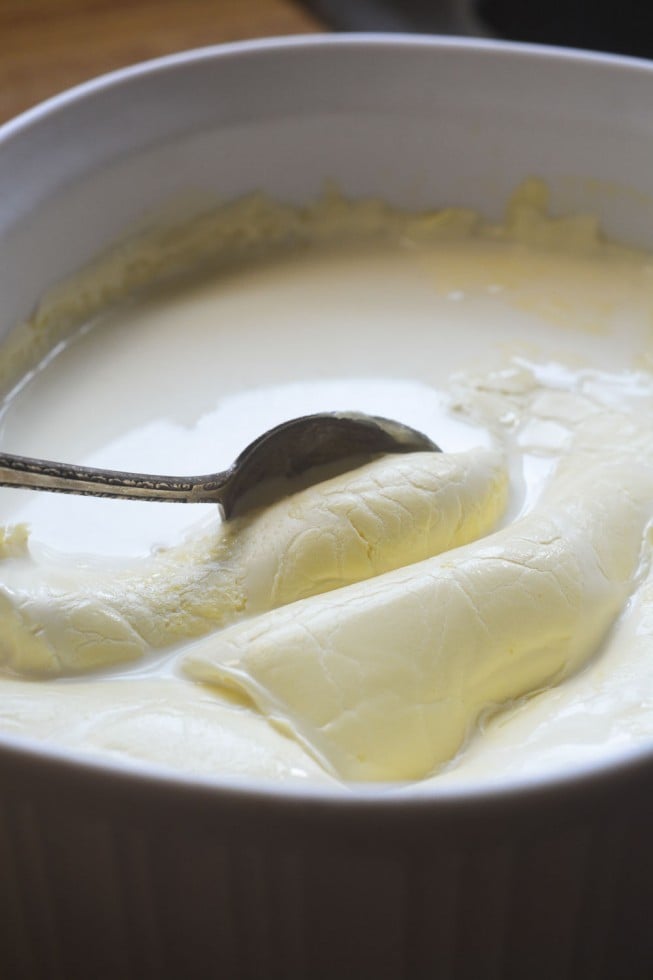
How long does clotted cream last?
Homemade clotted cream can last for up to 3-4 days when stored properly in the refrigerator. To extend its shelf life, it’s important to keep it in an airtight container and store it in the coldest part of the refrigerator, such as the back of the bottom shelf.
It’s important to note that clotted cream does not have any preservatives, so it should be consumed as soon as possible for the best flavor and texture. If you notice any changes in color, texture, or odor, discard the clotted cream immediately as it may have spoiled.
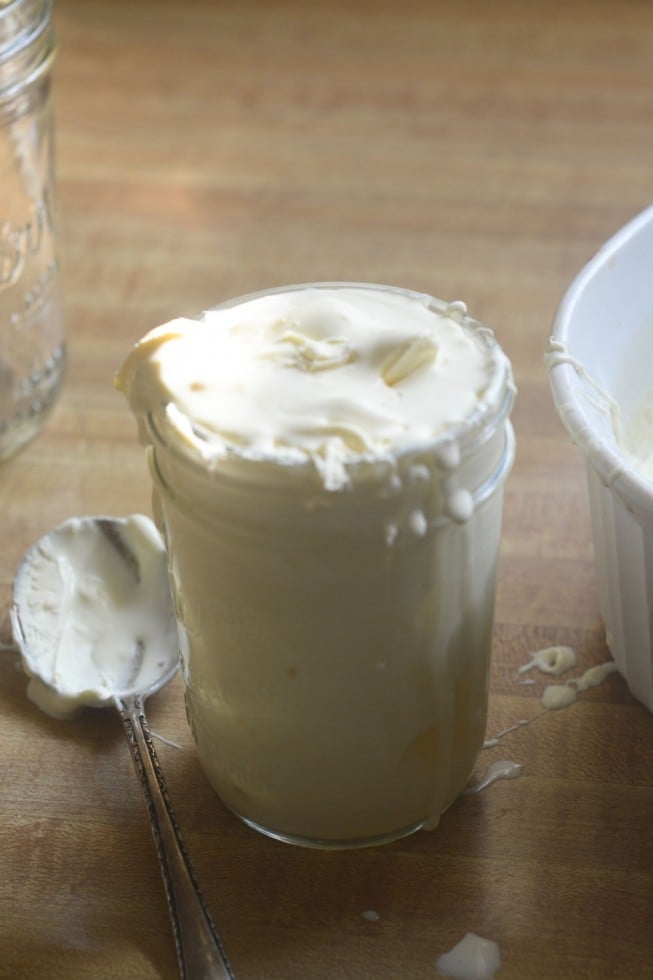
What to do with the leftover whey from making clotted cream
The leftover whey from making clotted cream can be used in a variety of ways:
- Adding it to smoothies or protein shakes for a boost of protein and nutrients.
- Using it as a substitute for milk or water in baking recipes such as bread, muffins, and pancakes.
- Using it as a marinade for meat or fish to tenderize and add flavor.
- Adding it to soups or stews for added richness and flavor.
- Using it as a liquid base for making homemade ricotta cheese or other soft cheeses.
- Feeding it to pets, as it is a good source of protein and nutrients for animals.
Note: It’s important to keep in mind that the leftover whey should be used or stored promptly to avoid spoilage. It can be stored in the refrigerator for up to a week or frozen for longer storage.
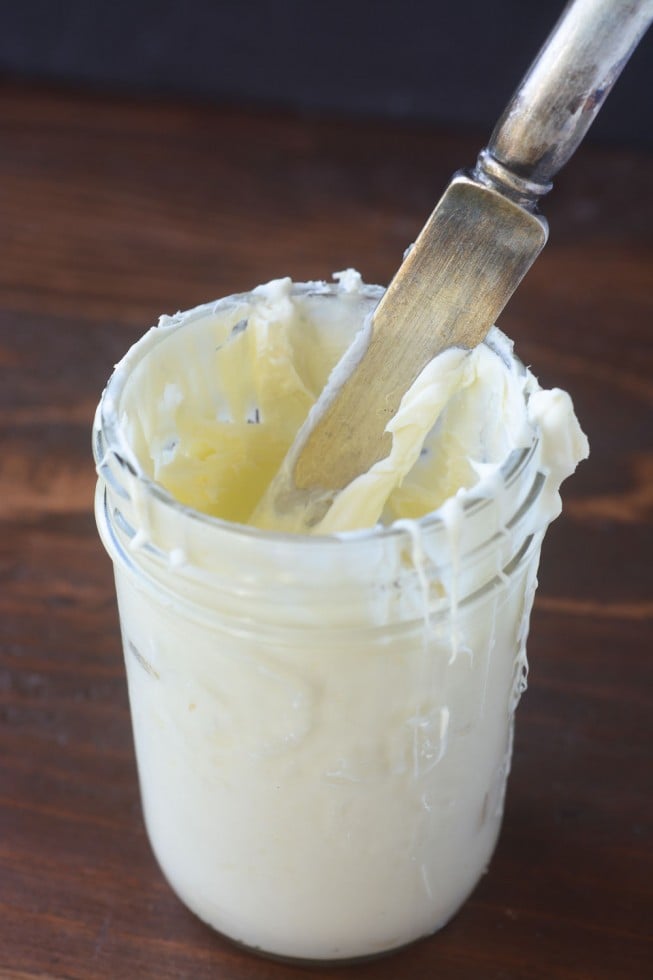
I can’t say enough good things about this project, the results far exceeded my expectations and it was absurdly easy. The only catch is that you can’t use ultra-pasteurized cream, which is cream that’s been processed for a longer shelf life. Many stores only sell ultra-pasteurized cream, so you have to search a bit for regular cream. I found mine at Whole Foods. Just read the labels… if it doesn’t say ultra-pasteurized on the label, you’re good to go.
can you make clotted cream with ultra-pasteurized cream?
Some readers in the comments below have had success with ultra-pasteurized cream. It is possible to make clotted cream from ultra-pasteurized cream, but it may be more difficult to achieve the desired texture and flavor. Ultra-pasteurization is a process that heats the cream to a higher temperature than regular pasteurization, which extends its shelf life but can also alter the proteins and enzymes in the cream. This can make it more difficult for the cream to form clots, which are necessary for making clotted cream.

What to eat with your homemade clotted cream
You will definitely want to make scones to go with your homemade clotted cream. I have lots of recipes for scones on the blog, but a simple one to start with is my Classic Cream Scones Recipe.
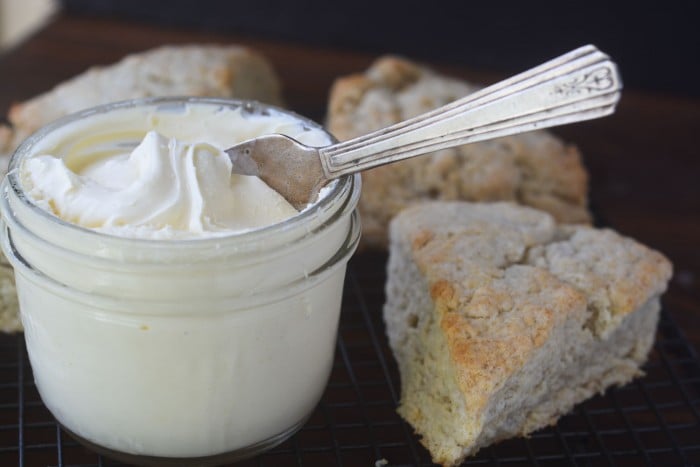
Tips for making clotted cream
- Make sure your cream is not ‘ultra pasteurized’, you will need to find regular pasteurized cream at a Whole Foods or other similar store. Ultra pasteurized cream has been treated in a way that prevents it from ‘clotting’.
- An oven thermometer is an essential kitchen tool, and really comes in handy for this project. If your oven is too cool or too hot your homemade clotted cream will not ‘clot’. Set your oven to 180F and then check the thermometer. You can adjust up or down as necessary.
- If your oven does not go down as low as 180F you can try one of my other methods for making clotted cream:

Homemade Clotted Cream
Video
Equipment
- a heavy casserole dish
Ingredients
- 2 pints heavy cream or whipping cream (double cream in the UK), avoid ultra-pasteurized cream for best results.
Instructions
- set your oven to 180F
- Pour the cream into the casserole dish. It should come up about 1-3 inches on the side.
- Set the dish, uncovered, in the oven and leave undisturbed for 12 hours. Be sure to leave the oven on the whole time. I do this overnight.
- Remove the dish from the oven and set to cool. Then cover and refrigerate. Note: the cream may seem thin at this point, but is going to thicken considerably overnight.
- The next morning scoop the thickened cream into a jar or jars, and cover and put back in the refrigerator. You can use the leftover cream for baking..
- Spread the clotted cream on freshly baked scones.
Nutrition


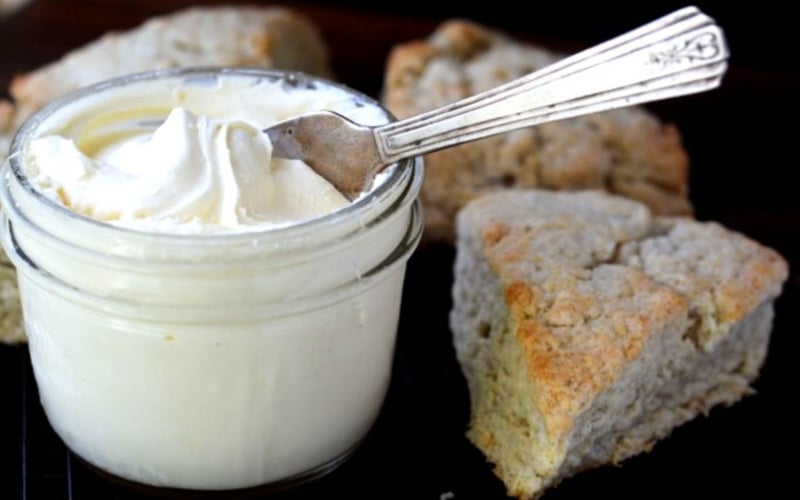












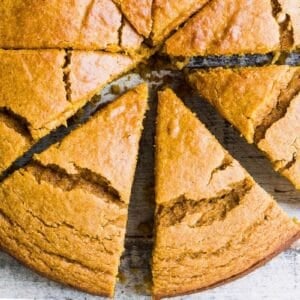







Do you think the left over cream could still be whipped into butter?
I don’t think there’s enough butterfat left in it, it’s very thin.
Hi Sue! I’m just wondering if it would be bad to try this recipe out with an oven that only goes down to 200 F / 95 C? Is that pushing it too high? Let me know (: Thanks!
It’s a very specific process Grace, and I think that might be too high. You might try it, though, if you’re willing to take the risk.
The lowest my oven goes is 200 degrees. Do you think that will be too hot?
Thank you for your time!
I think it may be Amanda, this is such a specific process. You might try it, though, because you’re pretty close! If you have an Instant Pot you can try that method.
I am in the middle of making clotted cream for the first time. I brought the heavy whipping cream to a boil in a Dutch oven on a gas stove, let it boil for a couple of minutes (hope that was OK–just wanted to make sure any harmful bacteria was killed!), and then put the cream in an Instant Pot for 8:30 hrs. The Insta Pot doesn’t have a yogurt setting, so this was my best approach. Now it’s cooling and will then go into the fridge for the night. I just want to make sure I wasn’t supposed to boil the cream for longer, for safety? I don’t want to make anyone sick! Thanks!
Well, this is such a precise process Kari, I’m not sure yours is going to come out. You only need to bring it to a simmer since all cream is pasteurized already, and I wonder what setting you used in the Instant Pot? The keep warm setting should be too high, I think. Check out my oven method if you want to try again. It’s linked in the post. Let me know how it came out if you get a chance!
I didnt read anything in your directions about simmering cream??? Do you simmer on stove before putting in oven?
No, just put it in as is.
Hi Sue, When this cream cools, does it end up with a skin? if so, would covering it with plastic wrap (directly on the cream) stop that problem?
When the cream finishes cooking it often has a thick crust on top, which is part of the clotted cream. As it chills in the fridge it just gets thicker. I don’t think covering with plastic would change anything, because the crust is already part of it, before it even chills, if that makes sense.
It was perfect! I was scared cause it was runny but set up in frig just fine.
I left it in for approx 12 hrs and it was so thick it just peeled back , i could of rolled it jellyroll style, so much clotted cream.
I put in for 4 hrs 180, then 170 for 4 hrs and finished at 180. Was afraid it would darken, used Trader Joes blue cap heavy cream.
I have never had clotted cream.I see why one would use jam to bring out flavor.
Yay! People do tend to get worried before they’ve chilled it, it really does set up nicely overnight.
How long does the clotted cream keep?
It will keep for 2-3 weeks.
I just stumbled across your website, looking for shortbread recipes, and am delighted to find your recipe for clotted cream! I intend to give it a whirl. I grew up when milk was purchased raw, and pasteurized at home by boiling it twice on the stove top. In the process, the cream would rise to the top. My grandmother would always skim it off on to a cold saucer and save it for me in the refrigerator for an after school treat. It was beautifully thick! The process you describe for clotted cream is also the same for making a baked sweet yogurt that is particular to the region of Bengal and Bangladesh. I find you website delightful, and your photographs are lovely!
Welcome in Feryall, I’m so glad to have you here. I bet you’ll give us some interesting perspectives on these recipes, please feel free to chime in whenever you want!
I was just watching a Cornish cook making clotted cream and thought I’d share his tips with you. He pre-heats the oven to 340 F/160 C then puts the pan in the middle of the oven and turns it OFF. Leave it there for 10-12 hours without moving it. Don’t open the door either. You can leave it in the oven over night. You don’t get the crust if you do it like this.
When it’s time to take it out just carry it as it is and put it in the fridge. Don’t move the pan too much. Let it sit for 8 – 10 hours.
Use a colander and a bowl for the liquid. Cut a hole in a corner of the cream and pour the liquid into the colander.
Thanks Anna!
So sorry I’ve looked through quite a few comments but can’t find my answer – what size dish did you use?
AND does it matter the material of the dish? Glass or…?
I don’t think it matters what the material is, mine was porcelain. Glass would be fine.
I attended a craft fair last weekend here I tasted clotted cream for the first time…I was hooked. I was able to find raw cream at Sprouts Grocery and just put my cream in the oven to clot. Do you think the cream left after clotting would still be able to be whipped into butter, or does the oven cooking remove too much of the fat content? Thank you.
The process separates out the butterfat into the ‘clots’, so the remaining whey is watery and thin.
I used an oval casserole, the important thing is that the cream should be about 2 inches deep.
So we were in London for Easter of 2012 and had our first Clotted Cream and I have looked for a good recipe ever since! This makes my day! Thank You!! Would love a video that shows the colored cream as you take it out of the oven, then a clip of it after cooking overnight and then one of it as you put it into jars. I can not wait to try this!!!
So I’ve made clotted cream twice now in the same style and way you do. I’m able to get my hands on unpasteurised cream, which has a luxurious amount of fat, however, would this make it more cheesy? I’ve had an issue with my clotted cream developing a sort of cheesy taste if I mix in the crust, so much so I can’t use the crust or it’ll taste strange. Is this normal? Should I just try the Whole Foods pasteurised cream instead?
Traditionally clotted cream would be made with unpasteurized cream, so I’m sure it would work, but I’m not sure how that would affect the flavor. As for the crust issue, you might try lowering your oven temperature just a bit, your temp might be a little high, and making an extra ‘crusty’ crust.
I’ve found that the pasteurization isn’t as big an issue as the fat content in your cream. If you can find a really heavy whipping cream- with the thick layer of fat on the top- it works great. Trader Joe’s whipping cream in the pink capped bottles will do it and so will the blue Kroger brand bottles of heavy whipping cream.
Beth- that pink cap.from trader joes is the absolute best! I agree!
It works great!